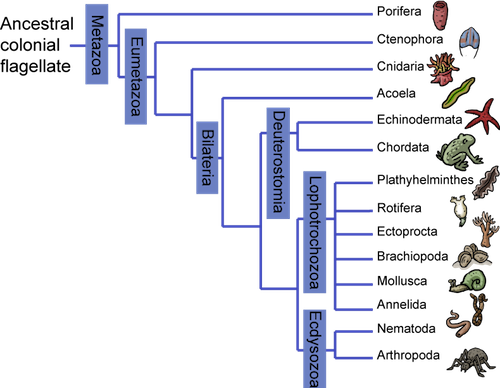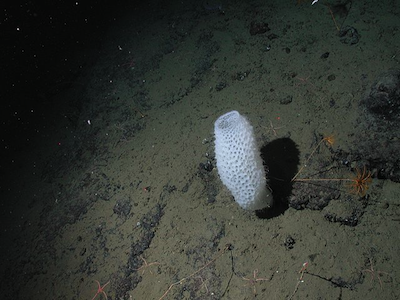Draw the Family Tree of Animal Kingdom
The Animal Family Tree
We are family. All animals are related, but figuring out the relationships is not straightforward. Traditionally, the family tree has been based on body plan and how embryos develop. Animals with common characteristics are considered more related. More recently, scientists have used molecular data to figure out which animals share the most DNA and are most closely related. This shakes up the family tree, but it is always a work in progress. We can think of another family that is a work in progress.
If you base the family tree on body plan and embryonic development, you get a family tree something like this. This is also called a cladogram, a diagram that shows relationships.

Start reading this from the bottom. Each time a branch splits, there is a major change in animals. For instance, the first split at the bottom is between sponges, which do not have real tissues, and everything else. All other animals have tissues formed during gastrulation. The next break is between animals with radial symmetry, the radiata, and animals with bilateral symmetry, the bilateria. And, so it goes.
With new molecular information, it looks more like this:

Both cladograms agree on the early branches, but the organization differs further up in the tree. This doesn't mean that the animals we have are any different, just that we are not entirely sure which cousins are further removed. For instance, annelids (one of the many kinds of worm-like animals) and mollusks (like clams and oysters) used to be grouped with insects and now are grouped with lamp shells and tube worms.
Animals are grouped into about 35 phyla (phylum, singular). These phyla separate the kingdom into different branches. After that, we break down the categories until we reach the level of species. Here are the levels of organization:
- Kingdom
- Phylum
- Class
- Order
- Family
- Genus
- Species
Here's a way to remember: King Philip Cried Out For More Good Soup.
Animals and Sort-of-Animals
The first big branching in the animal kingdom is between parazoa and eumetazoa. Parazoa means the kind-of-like-animals. Parazoans share most of the basic characteristics of animals, but lack true tissues. The one phylum here is Porifera, the sponges. Eumetazoa are everyone else.

Image from here.
The animals in the next branches of the tree differ in how they develop from a single cell into a multi-cellular form. As a sexually reproducing organism, an animal starts with the combination of two single cells, a sperm and an egg, each of which has half of the chromosomes needed for one individual. These cells form a zygote, which goes through repeated cell divisions, called cleavage, to form a multi-cellular ball called a blastula. The blastula keeps dividing and acquires different layers that will become different tissues. This process of dividing into tissue layers is called gastrulation.
A defining difference between animal phyla is in how this little ball of cells grows. In most animals, the ball forms layers that will become different tissues. Sponges don't do this, which is why they are off in their own group, parazoa. The eumetazoa—everyone else—have a blastula that forms germ layers, not to be confused with those germs that cause sickness. Germ also means the beginning of something. Germ layers develop into tissues. Different animal phyla may be diplo- ("two") or triploblastic ("three layers"), depending on how many germ layers are formed.
Two Basic Models
Eumetazoa are divided into two basic body styles. With cars, we can get a sedan or SUV. Animals have just two basic body styles. They are based on symmetry: bilateral or radial. Radial symmetry is where there is a top and bottom but no front and back or left and right. Think of a perfect pumpkin. We know which end is up but the sides are all the same. Bilateral symmetry is where there is a top and bottom, but also front and back and left and right. Look at someone's head: top, bottom, front, back, left, right. At least we hope so. In radial symmetry, each section is a mirror image of every other section, no matter which way you cut it. In bilateral symmetry, the right side is a mirror image of the left side, but the top is not a mirror image of the bottom.
Try this animation showing bilateral vs. radial symmetry.
Whew. Lots of stuff going on and very little we can see without a microscope. What's the deal? Different animals go through this process in different ways. These differences, which happen so early on in development, are thought to be major separations in the evolution of animals. Each time a change in development comes around, it leads to a new branch of animals.
A Few Ways to Get There
Bilateria can be divided into two more big groups, based on differences in how the embryo develops: protostomes and deuterostomes. Both have an internal space called a coelom, and a hole at either end, but they each get there differently.
Cleavage, the process of cells dividing, can happen two ways.
- Protostomes go through spiral cleavage. Spiral cleavage is when the cells split at an oblique angle from the up and down axis of the embryo.
- Deuterostomes go through radial cleavage. Radial cleavage is when the cells split either parallel or at a right angle from the axis.
There are a few other distinctions between protostomes and deuterostomes.
- Determinate vs. indeterminate cleavage: Protostomes go through determinate cleavage. This means that from the very beginning each cell has a distinct fate. We can't take one cell away and have a viable embryo. Deuterostomes go through indeterminate cleavage. Up to a certain point, any one cell still has the ability to become a whole embryo.
- Mouth vs. anus: During gastrulation, the point when the gut is forming, an opening to the outside is formed called a blastopore. In protostomes, this becomes the mouth. In deuterostomes it becomes the anus. Second openings later form the opposite hole for both.
- Coelom development: The coelom also forms differently in these two groups. In protostomes, the coelom develops from tissue that splits off completely from the mesoderm (or middle germ layer). This is called schizocoelous development ("schizo-" means split). In deuterostomes, the coelom forms from tissue that pokes out from the mesoderm, also called enterocoelous development.

Coelom Issues
But wait, there's more. Within the bilateral group, we also get three branches based on how the blastula forms an opening inside itself. As the ball of cells becomes layered, it's called an embryo, and layers of cells form around the coelom. One group of animals has three germ layers without a space. These are acoelomates ("without a coelom"). Another group has a coelom made entirely from the middle germ layer. These are coelomates. The last group has a coelom, but it is only partially from the middle germ layer and these guys are called pseudocoelomates ("sort of a coelom").
These three branches overlap a bit with the protostome/deuterostome distinction. All deuterostomes are coelomate. However, so are some protostomes. The rest of the protostomes are split between acoelomate and pseudocoelomate.
Brain Snack
The idea of six kingdoms of life is the current view, but others have existed in the past. Sponges were thought to be plants. (As were fungi—they now have their own group.)
Source: https://www.shmoop.com/study-guides/biology/animal-evolution-diversity/animal-family-tree
0 Response to "Draw the Family Tree of Animal Kingdom"
Post a Comment